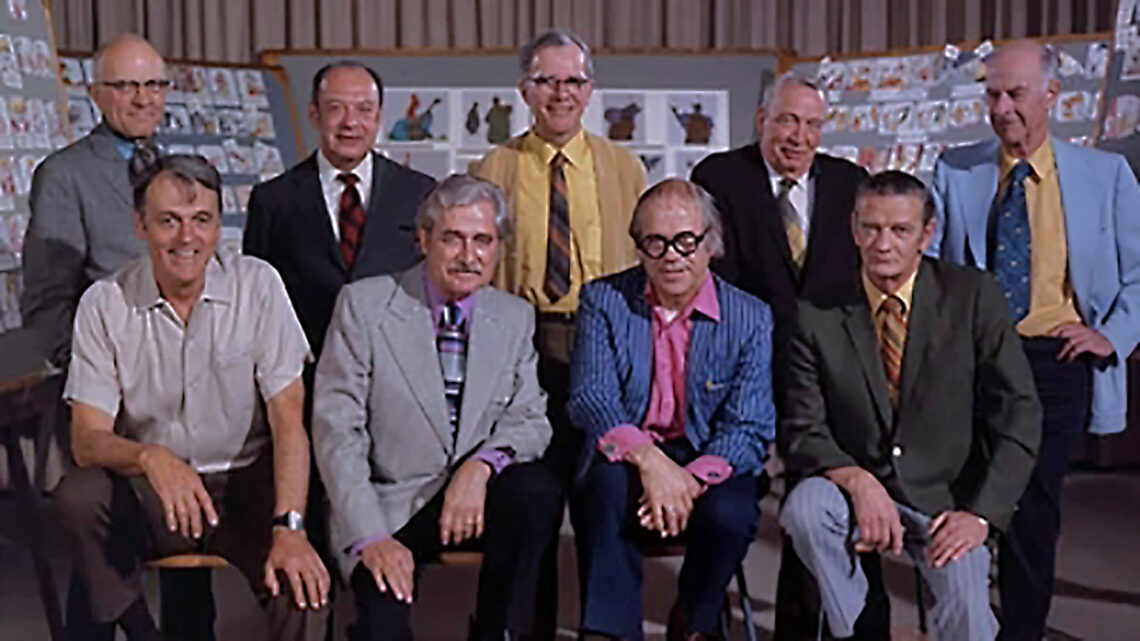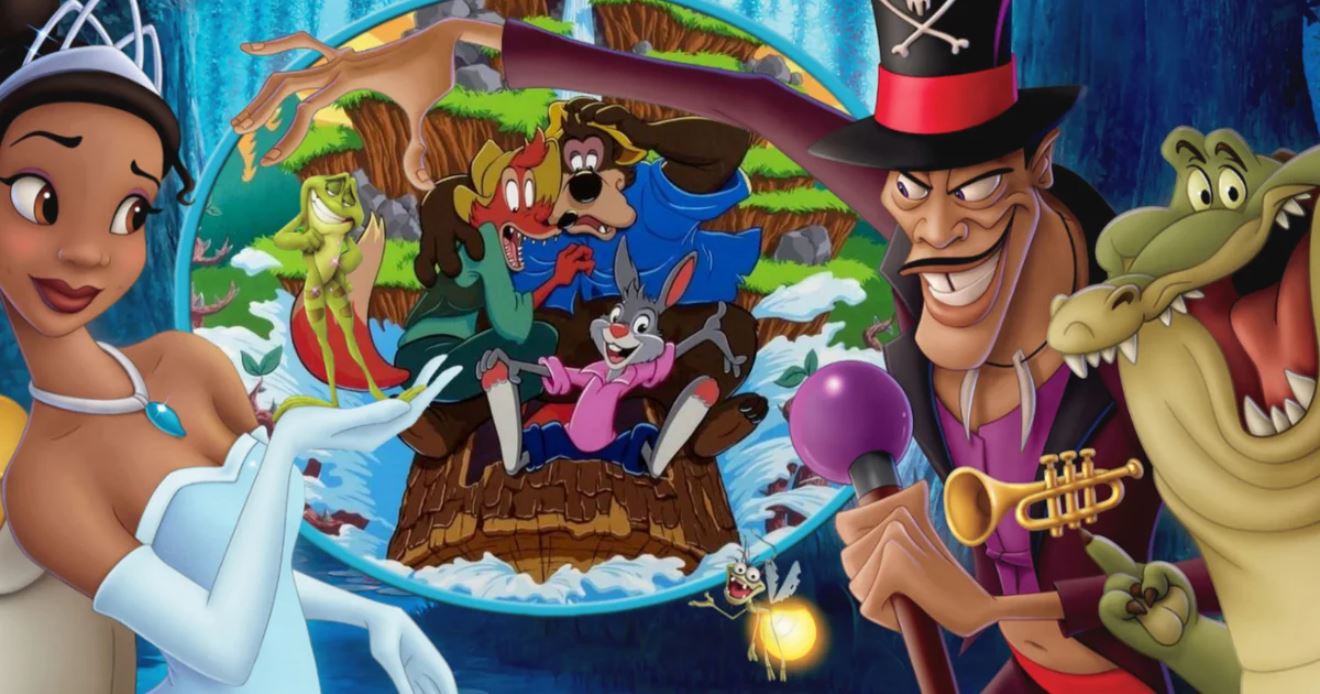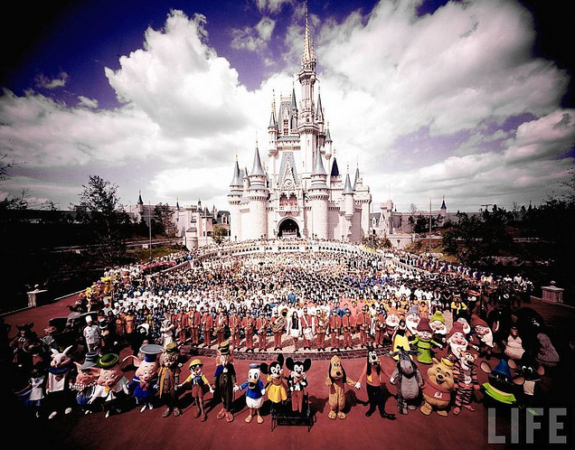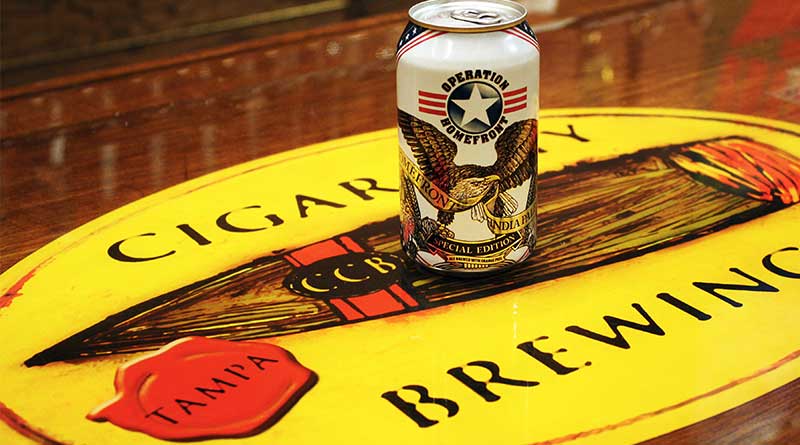
Walt Disney’s “Nine Old Men”…
Walt Disney, as all of us know was a brilliant showman, storyteller and animator. You might even say he was clairvoyant, for he seemed to know what would work and become successful, despite all odds to the contrary. But for many, the animator part was not quite true. Walt once famously quoted… “You can design and create, and build the most wonderful place in the world. But it takes people to make the dream a reality.” No one knew this more than Walt.
Although he studied the infant art form of animation, experimented and knew what he wanted, as an artist and draftsman, he was pedestrian at best. He animated most of his early works himself, but knew he needed superior talent for a polished product. After befriending and partnering with Ub Iwerks, who was a superior animator, who was known as the “Fastest Pencil in the Business”, Walt always recruited the best talent for his studio.
The finest known of these artisans were a core group of nine men which Walt gave the moniker his, “Nine Old Men”. Taken from Franklin D. Roosevelt’ Supreme Court Justices in 1936, the nine justices most of whom were over the age of 70 at the time, and Roosevelt was wondering if the older court was out of touch with the times. But Disney’s animators were far from “out of touch”. These nine animators were at the forefront of the business, and all developed new innovations and techniques with everything they touched, and they were in their thirty’s. Now, this is not in anyway to detract the amazing contributions to all the other craftsman and artists Walt employed, but these nine men had a hand in every major animation triumph coming from the studios from the early 30s’ to 1986, when Eric Larson worked on the as Mickey’s Christmas Carol and The Great Mouse Detective. He retired in 1986.
Over time, some of the “Nine” later became directors, who created some of Disney’s most famous animated cartoons, from Snow White and the Seven Dwarfs (1937) to The Rescuers (1977), they worked on feature and short films. Disney delegated more tasks and responsibility to them in the animation department in the early 1950s as their interests and scopes expanded. All members of the group are now deceased, and are acknowledged as Disney Legends. Each of them was separately honored with the Winsor McCay Award (lifetime achievement award for animators) during the 1970s.
Let’s take a look at these amazing Animators…
LES CLARK -November 17, 1907 – September 12, 1979
Les Clark was the first to be hired. The story is that in high school, he worked at a soda shop nearby Walt’s studio which Walt frequented. Les did artwork on the menus and had pictures on the walls which Walt complimented him on. After graduation, Les went to the studios for a job, and was asked to see some of his work. Les remembers Walt’s reply…’Bring some of your drawings in and let’s see what they look like, “So, I copied some cartoons and showed them to Walt. He said I had a good line, and why don’t I come to work on Monday”? Walt hired him on February 27, 1927 in temporary capacity.
Les had the distinguished honor of working with Ub Iwerks when the development of Mickey Mouse began. He became an inbetweener (Filling in the actions between drawings of the animator) working on the future Steamboat Willie. He was promoted to animator, working on the Skeleton Dance, working on the scene of a skeleton playing another like a xylophone. When Ub left the studio, Les took over as lead animator on Mickey. He made contributions to many classics, i.e. Dumbo and Fantasia and became a director on such classics as Peter Pan and Alice in Wonderland. Other highlights were Lady and the Tramp, Make Mine Music, Pinocchio and Cinderella. Les retired-on September 30th, 1975.
Frank and Ollie said of Les…” Les went quietly ahead of what he did best, constantly at art class, working hard to improve and learn. There was much admiration for this quiet and thoughtful man, who came in with no art background, yet through sheer determination and desire not only kept up but helped advance the art with his refinement of the fundamentals”.
WOLFGANG REITHERMAN -June 26, 1909 – May 22, 1985
Wolfgang Reitherman, aka “Woolie” was born in Munich Germany, his family moving to America when very young was hired by Walt on May 21st, 1933, began working on June 1st, 1933. He first began working the shorts “The Wise little Hen (Donald Ducks debut) and “Funny Little Bunnies”. He moved on to the Silly Symphony’s, Mickey Mouse, and Goofy cartoon shorts. He worked on the Magic Mirror in Snow White and the Seven Dwarfs. During WWII, Woolie fought as a fighter pilot and became an Ace, garnering the distinguished Flying Cross. After returning to Disney, he was known as the “Action Man”, animated films including the Monstro the whale in Pinocchio, the dinosaur fight in The Rite of Spring in Fantasia, and the Headless Horseman chase in The Adventures of Ichabod and Mr. Toad. He worked on characters such as Tick-Tock-Croc, the White Rabbit and Jaq and Gus.
Reitherman became the first person in company history of the studio to direct an entire animated feature film, “The Sword and the Stone” Ward Kimball said of Woolie…” He didn’t think he was a good artist, even though he was. He was always stuck with the chase stuff because most people hated to do that, but Woolie got a big kick out of doing fast, action wild out stuff and did it well” During the fifty’s, Woolie began directing instead of animation, both the shorts and films. After Walt Disney passed away in 1966, Wolfgang took over as producer for the animation department and produced every animated film from The Aristocats to The Fox and the Hound, retiring in 1981.
ERIC LARSON – September 3, 1905 – October 25, 1988
Eric Larson began work at the studio on June 1st, 1933 (Same day as Wolfgang) as an assistant animator on various shorts, Two Gun Mickey and the Tortoise and the Hare. He moved to animation on “Snow White and the Seven Dwarfs”. By 1940, he became animation director, animating the horses and Centaurs for the Pastoral Symphony segment in Fantasia. With Marc and Les he worked on Cinderella and the animation of the Caterpillar for “Alice in Wonderland” Eric was lead animator on Peg in Lady and the Tramp and he created the “You Can Fly, You Can Fly, You Can Fly” scene in Peter Pan.
His most outstanding work was the flying sequence to Neverland in 1953’ “Peter Pan”. He did work for the singing animals in “Jolly Holiday” in Mary Poppins and drew on inspiration from growing up on a farm. After Walt’s death, Larson began a training program, aimed at new talent. Some of the animators going through the program were John Lasseter, Tim Burton, Andreas Deja and Glen Keene. Larson retired in 1986, after 52 years with Disney. He was the last of the “Nine” to retire.
MILT KAHL -March 22, 1909 – April 19, 1987
Milt began his career at Disney on June 25th, 1934. He said he was motivated to work at Disney after seeing the “Three Little Pigs”. As with most new hires, Milt started as an animation assistant on various cartoon shorts, “Mickey’s Fire Brigade” and “Mickey’s Service Station”. He contributed on animating the woodland creatures in Snow White and the Seven Dwarfs. After senior animator Freddy Moore saw Milt’s drawings of Pinocchio, he moved on to directing animator of that feature film. Other major contributions were Bambi, Saludos Amigos, Pecos Bill, Song of the South, Peter Pan and Cinderella. He was considered the best draftsman and best drawing of human figures at the studio. He also worked on many villains and sidekicks such as Madam Mim, Shere Khan, Kaa, Madame Medusa, and Mr. Snoops. Animator Floyd Norman stated of Milt…” Milt Kahls contribution to the art of Disney animation is immeasurable, and his work continue to delight millions for years to come. If indeed, animators could be considered royalty, there’s no doubt that Milt Kahl would be king”
WARD KIMBALL – March 4, 1914 – July 8, 2002
Ward started with Disney on April 2, 1934. Again, like others he began as an inbetweener on “The Goddess of Spring” and “Orphan’s Benefit”. His most popular works included Jiminy Cricket, Lucifer, the Mad Hatter and Cheshire Cat, and the Lost Boys in Peter Pan. He directed the shorts “It’s Tough to be a Bird” and “Toot, Whistle, Plunk, and Boom” He designed Jiminy Cricket, he created the Television series “The Mouse Factory” and was directing animator of “The adventures of Ichabod and Mr. Toad”. Ward was a huge Railroad enthusiast, who had a full-sized train and tracks at his home. He inspired Walt, another train lover to install the Carolwood Pacific Railroad, a 1/8 scale ridable train at his home also, and was instrumental in placing a steam train around Disneyland.
Walt’s brother Roy O. Disney said of Ward…” He was a brilliant animator and filmmaker with a distinctive style and humor all his own”
FRANK THOMAS – September 5, 1912 – September 8, 2004
Frank made his Disney debut on September 24th, 1934. His first work included the shorts, “More Kittens” and “Mickey’s Circus” Soon he graduated to animated films and was instrumental in the spaghetti kiss in “Lady and the Tramp”, the puppet show in Pinocchio and the Ice-skating scene in Bambi. He animated all seven Dwarfs in Snow White. Frank was unequaled at creating villains, i.e. the Queen of Hearts, Captain Hook and Lady Tremaine. And like other animators during WWII he fought overseas and returned to work for Walt. Now he was a master animator, he was directing animator for the “Jungle Book” and “Sword and the Stone”
Frank was a close friend with fellow animator Ollie Johnson both attended Stanford University, where he was a member of Theta Delta Chi fraternity and worked on campus humor magazine The Stanford Chaparral with Ollie. He was also a member of Ward Kimball’s “Dixieland band Firehouse Five plus Two. Frank retired on January 31st, 1978. Thomas and best friend Ollie Johnson joined forces on many projects, including the iconic animation book, “The Illusion of Life” Frank’s advise to many aspiring animators…” Observe everything, Communicate well, Draw, Draw, Draw.
OLLIE JOHNSON – October 31, 1912 – April 14, 2008
Ollie was hired by Disney on January 21st, 1935 and joined his life-long friend Frank Thomas. Starting as an inbetweener for the Mickey shorts “Mickey’s Rival” and “Mickey’s Garden”, he progressed to directing animator for 20 feature animated films. Johnson often animated character pairs, i.e. “Pongo and Perdita”, Anastasia and Drizella Tremaine” and “Jock and Trusty”, “Sir Hiss and Prince John” and “Baloo and Mowgli”. Ollie also penned “Mr. Smee” in Peter Pan. And working with Frank, they both animated and created the penguin waiters in Mary Poppins, and Sleeping Beauty’s good fairies, Merryweather, Flora and Fauna.
Ollie, like Ward Kimball both loved live steam trains and he also had his own backyard railroad. He also was a major influence in Walt’s love of the hobby and his own Carolwood Pacific Railroad in his backyard. Film historian said of Johnson…” People know his work. They know his characters. They seen him act without realizing it. He was one of the Pillars, one of the key contributors to the golden age of Disney animation”
Ollie was recognized by the Disney Company in 1989 with the Disney Legend Award, and his work also honored with a National Medal of Arts in 2005. The last surviving member of Disney’s Nine Old Men, Ollie Johnston died of natural causes on April 14, 2008, at the age of 95.
MARC DAVIS – March 30, 1913 – January 12, 2000
Marc was the last of the Nine old Men to join Disney on December 2nd, 1935. Later, he was transferred to Disney’s Design and Development Dept. the forerunner of Walt Disney Imagineering. He was one of the first “Imagineers”. Marc started out on Snow White and the Seven Dwarfs doing clean up animation. Marc’s memorable contributions were his animation of Disney’s famous women. He created Tinker Bell, Alice, and Cinderella along with Les Clark. He was also directing animator on Cruella de Vil, Aurora and Maleficent. He was known as Walt’s “Renaissance Man”
In addition to his animation skills, as Imagineer he was instrumental in Disneyland’s classic attractions, i.e. Pirates of the Caribbean, the Jungle Cruise, It’s a Small World, the Enchanted Tiki Room and the Country Bear Jamboree. He contributed on all four attractions for the 1964-1965 New York World’s Fair. Even after retiring in 1978 he still worked as a consultant for the development of Epcot and Tokyo Disneyland. In addition, his wife Alice was a costume designer for Disney and she designed all of the costumes for the dolls in It’s a Small World and for the audio animatronics in Pirates of the Caribbean.
JOHN LOUNSBERY – March 9, 1911 – February 13, 1976
John was hired at Disney on July 2nd, 1935. It is interesting to note that while taking art instruction at the Art Center School of Design in Los Angeles, one of the instructors was so impressed with John’s artwork he suggested that he interview for a job at Disney. He began as an animation assistant on Snow White and the Seven Dwarfs, and he contributed to many of the early Pluto short films, such as Private Pluto, Pluto at the Zoo and Pluto’s Playmate. Other characters he worked on were J. Worthington Foulfellow and Gideon, Tony and Joe, King Stefan and King Hubert, the Darling Family and the elephant brigade in the jungle book.
During WWII, he contributed to a number of propaganda shorts, including the Three Caballeros and Victory through Airpower. He was directing animator for the Dance of the Hours segment and was a co-director on The Rescuers and Winnie the Pooh and Tigger Too. His favorite character was Ben Ali Gator. John preferred to draw with a carpenter’s pencil instead of a drawing pencil. He also employed the Stretch and Squash animating technique which is seen in many of his characters, which made them quite comical.
Animator Don Bluth stated…” John was not a pretentious man, but very much a teacher. Very kind and very sharing with all of his information”. John was the only one of the Nine Old Men to have passed away while he was still working at the Studios. He is best known as one of Disney’s Nine Old Men, of which he was the shortest lived as well as the first to die.
So, for the many Disney Fans world-wide who love and cherish what Walt Disney has left the world, these nine talented craftsmen and animators were the core reason the Disney Company accomplished so much, and with techniques and skills not privy to other animation studios. Many never heard of the Nine old Men, nor knew their names, but now read a bit on how so much of that Disney magic emanated from these individuals, so you are now introduced to Disney’s Nine Old Men…!





